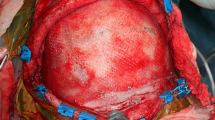Abstract
The surgical repair of large calvarial defects is still a challenge for craniofacial surgeons. Since the discovery of bone growth factors, numerous studies have confirmed the interest of osteoinduction for bone repair. We summarize the findings of experimental and clinical trials carried out with composite bone substitutes. The triple mixture of TGF-β1, fibrin glue, and natural coral has proven effective in repairing rabbit skull defects. The same preparation was also efficient for a cranioplasty in two of three patients, age being a limiting factor. The adjunction of bone morphogenetic protein to autologous bone marrow was shown to be a potentiating factor in a rat cranioplasty model, but the combination of fibrin glue and bone marrow on a natural coral carrier was unable to achieve bone repair in children aged 6 years. Although the series were limited, stability and asepsis were important factors in promoting bony ingrowth. Cranioplasties with osteogenic biomaterials may be good option, but the most adequate dose of growth factor should be determined.
Similar content being viewed by others
Author information
Authors and Affiliations
Additional information
Received: 3 January 2000
Rights and permissions
About this article
Cite this article
Arnaud, E. Advances in cranioplasty with osteoinductive biomaterials: summary of experimental studies and clinical prospects. Child's Nerv Syst 16, 659–668 (2000). https://doi.org/10.1007/s003810000321
Issue Date:
DOI: https://doi.org/10.1007/s003810000321




